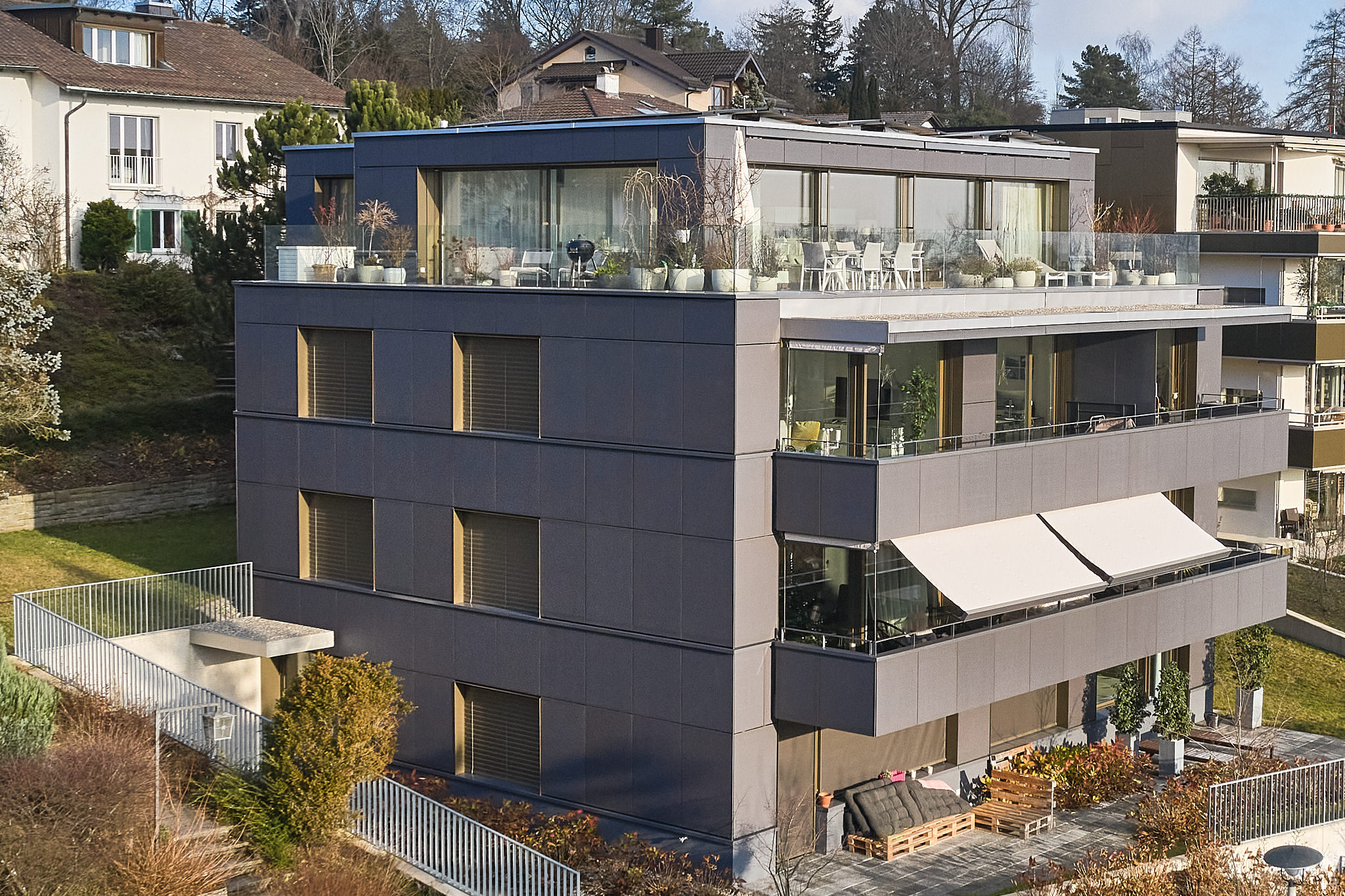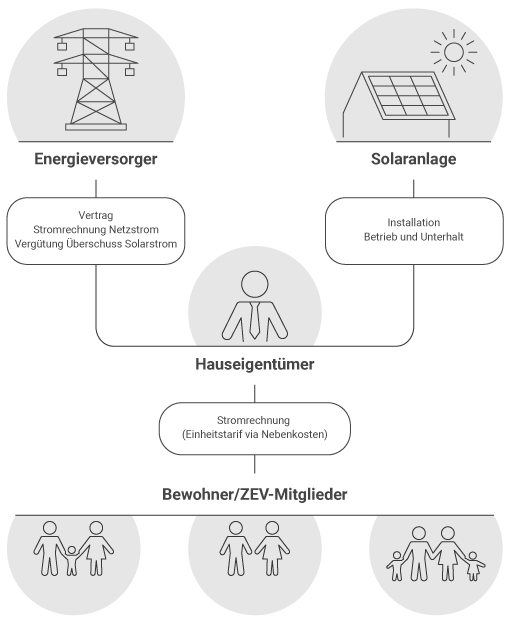Financing, funding instruments and returns
Thanks to lower costs for materials and installation as well as improved framework conditions, many solar plants can be built and operated profitably today. This means that the value of the solar energy as well as savings in electricity purchases pay back the costs of the system.
Economic efficiency
Own consumption

Produced solar electricity (orange curve) is (self-)consumed (red) in real time in the connected buildings and thus replaces the purchase (blue) of electricity from the electricity supplier at the daily tariff. This tariff is usually higher than the tariff for feeding surplus electricity into the grid. Therefore, the higher the self-consumption, the more economical it is to operate a solar system. Self-consumption can be increased with various measures:
- Mounting the solar modules in an east-west orientation. This results in a balanced daily production and the self-consumption increases. For the economic efficiency, the positive effect is higher than the slight loss of yield compared to a south-facing system.
- Charging of electric vehicles during the day with solar power. Operation of household appliances manually or automatically in sunny midday hours.
- A heat pump can heat a storage tank with hot water during the day, thus consuming excess solar power and is therefore less frequently in operation at night.
- Storing solar energy during the day in batteries. Accordingly, less is fed into the grid.
- In the evening/at night, the energy can then be consumed in the house, thus reducing electricity purchases.
Funding instruments and framework conditions
One-time payment (OTP)
The OTP is a one-time subsidy of max. 30% of the investment costs of a solar system. The amount of the OTP is reviewed annually and adjusted if necessary, the last reduction took place as of January 2023. There are three variants:
Small (SOTP)
- Up to 100 kWp plant size
- Registration after installation. However, the subsidy is considered secure.
- Waiting period currently approx. > 1 year (statement by the Swiss Federal Office of Energy, media release dated November 24, 2022)
- Larger installations can receive the Small OTP if they waive the share above 100 kWp.
Big (BOTP)
- 100 kWp to 50 MWp plant size
- Application can also be made before installation. Funding commitments are made in the order of applications and according to the available funding.
- Waiting period currently approx. > 1 year (statement by the Swiss Federal Office of Energy, media release dated November 24, 2022)
High (HOTP)
- The following condition must be met to apply for HEIV:
- All the electricity produced must be fed into the grid
- The plant must be operated for 15 years without self-consumption
- The plant must have a commissioning date as of 01.01.2023
- from 2 kWp plant size
- For systems under 150 kWp, the OTP is up to 60%.
- For plants above 150 kWp, the amount of the OTP is awarded in an auction.

Height of OTP for attached and freestanding plants
Amount OTP = basic contribution + (performance contribution + bonus) * performance solar system
Commissioning as of January 1, 2023
Basic contribution for systems from 2 - 5 kWp: CHF 200
Basic contribution for systems over 5 kWp: CHF 0
Performance contribution for systems under 30 kWp: CHF 400
Performance contribution for systems from 30 - 100 kWp: CHF 300
Performance contribution for systems over 100 kWp: CHF 270
Bonus if tilt angle over 75 degrees: CHF 100
Bonus for free-standing plants, if height over 1'500 m: CHF 250
Example plant (10 kWp, tilt angle 35 degrees, height 700m, in operation on January 1, 2023): 0 + (400 + 0 + 0) * 10 = CHF 4000
Amount of OTP for integrated plants
Amount OTP = basic contribution + (performance contribution + bonus) * performance solar system
Commissioning as of January 1, 2023
Basic contribution for systems from 2 - 5 kWp: CHF 200
Basic contribution for systems over 5 kWp: CHF 0
Performance contribution for systems under 30 kWp: CHF 440
Performance contribution for systems over 30 kWp: CHF 330
Bonus if tilt angle over 75 degrees: CHF 250
Example plant (10 kWp, tilt angle 35 degrees, in operation on January 1, 2023): 0 + (440 + 0) * 10 = CHF 4400
Amount of OTP for plants without own consumption
Amount OTP = (power contribution + bonus) * power solar system
Commissioning as of January 1, 2023
Performance contribution for systems under 150 kWp: CHF 450
Performance contribution for systems over 150 kWp: auctions take place at Pronovo
Bonus if tilt angle over 75 degrees: CHF 100 (attached) or CHF 250 (integrated)
Example plant (10 kWp, tilt angle 35 degrees, in operation on January 1, 2023): (450 + 0) * 10 = CHF 4500

Union for self-consumption
Now, several parties of a residential building, several parcels of land, several commercial enterprises can join together for self-consumption.
Design
- The participants establish an association for self-consumption. The electricity suppliers have contract templates.
- The participants connect their apartments or properties electrically behind a single meter. This serves as access to the public power grid.
- The remaining counters can be canceled.
- From now on, the merger will only receive a bill from the electricity supplier and will bill the internal consumption independently.
Conditions
- A responsible person represents the association to the outside world and pays the bills of the electricity supplier.
- Public land (e.g. road) may be crossed only with the consent of the owner.
- No use of the public power grid to transmit solar power between participating parties.
Advantages
- There is only one measuring point to connect the solar system, the self-consumption increases.
- The lifted meters save costs.
- If an association has an annual electricity consumption of more than 100,000 kWh, it is entitled to purchase electricity on the open market at market prices.
Disadvantages
- Administrative effort for internal billing of electricity consumption. Various service providers can take over this task at low cost.
- All participants behind the measuring point must use the same electricity product.
- If a USC decides to procure the electricity on the free market, a return to the basic supply is no longer possible.

Parties and functions of a USC
Tax benefits
Private users
Investments in solar systems can be claimed as maintenance costs against tax (exception: Canton Lucerne). At a typical marginal tax rate, buyers can save taxes in the range of 20-30% of the acquisition costs.
Commercial users
Investments in solar systems can be depreciated on a straight-line basis. The flexibility in depreciation allows the investment to be used in a tax-efficient way.
Links und Downloads
The adoption of the Energy Strategy 2050 has triggered various changes in the legal framework and support measures. The following ordinances are particularly important for photovoltaics:
Energy Subsidies Ordinance - Regulates the type and amount of subsidies Status 2017 | Amendments 2019
Energy Ordinance - Regulates in particular the connection to own consumption
